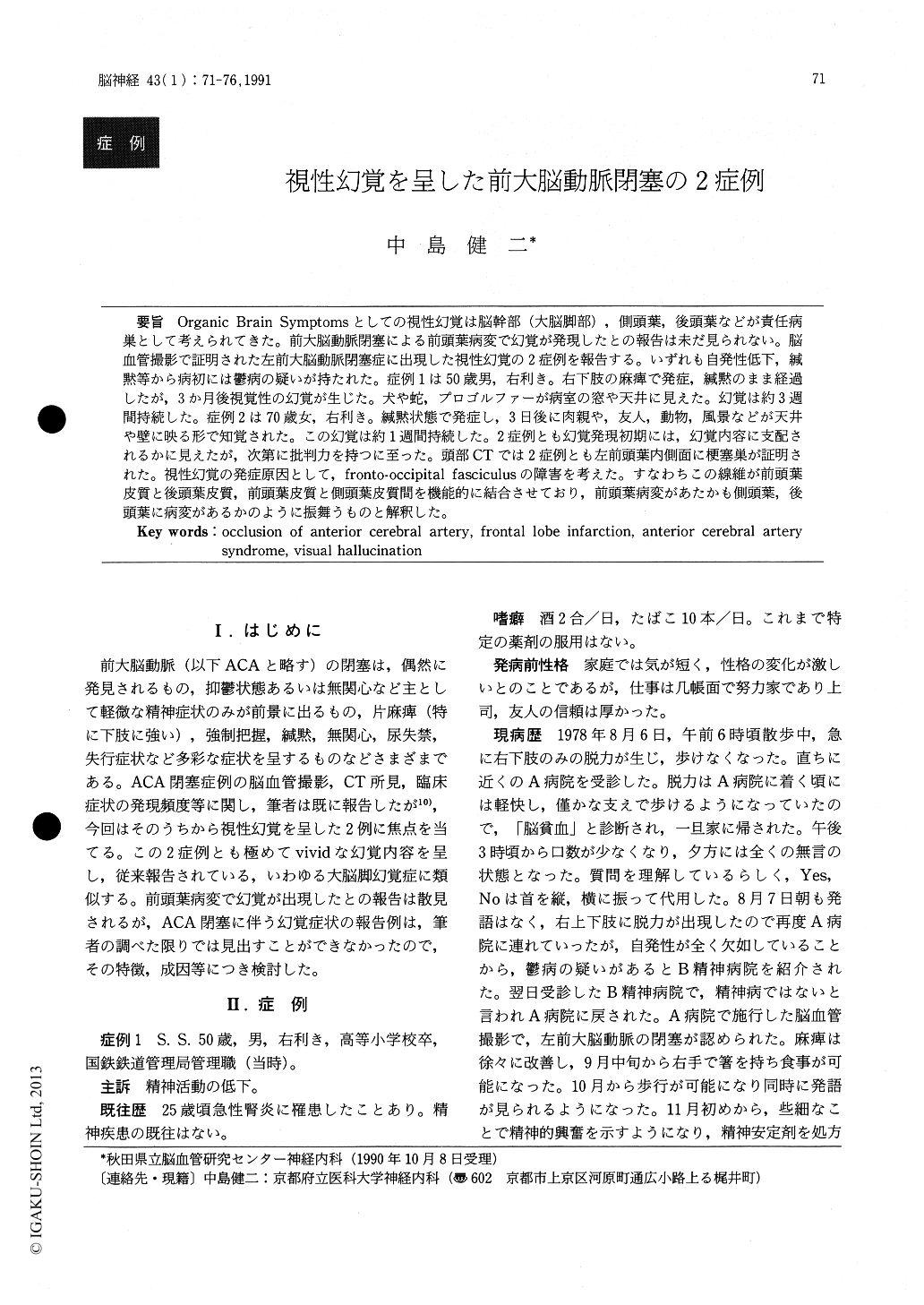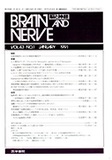Japanese
English
- 有料閲覧
- Abstract 文献概要
- 1ページ目 Look Inside
Organic Brain Symptomsとしての視性幻覚は脳幹部(大脳脚部),側頭葉,後頭葉などが責任病巣として考えられてきた。前大脳動脈閉塞による前頭葉病変で幻覚が発現したとの報告は未だ見られない。脳血管撮影で証明された左前大脳動脈閉塞症に出現した視性幻覚の2症例を報告する。いずれも自発性低下,緘黙等から病初には鬱病の疑いが持たれた。症例1は50歳男,右利き。右下肢の麻痺で発症,緘黙のまま経過したが,3か月後視覚性の幻覚が生じた。犬や蛇,プロゴルファーが病室の窓や天井に見えた。幻覚は約3週間持続した。症例2は70歳女,右利き。縅黙状態で発症し,3日後に肉親や,友人,動物,風景などが天井や壁に映る形で知覚された。この幻覚は約1週間持続した。2症例とも幻覚発現初期には,幻覚内容に支配されるかに見えたが,次第に批判力を持つに至った。頭部CTでは2症例とも左前頭葉内側面に梗塞巣が証明された。視性幻覚の発症原因として,fronto-occipital fasciculusの障害を考えた。すなわちこの線維が前頭葉皮質と後頭葉皮質,前頭葉皮質と側頭葉皮質問を機能的に結合させており,前頭葉病変があたかも側頭葉,後頭葉に病変があるかのように振舞うものと解釈した。
The author experienced two cases who showed visual hallucinations after they had had CT-proven cerebral infarctions in the left fronto-medial lobe. Cerebral angiography evidenced the occlusion of the left anterior cerebral artery at the genu portion (case 1) and after branching the frontopolar artery (case 2).
Case 1 was a 50 year old national rail way officer who had neither past history of a drug abuse nor that of psychoses. His initial symptom was right hemiparesis predominantly in his lower extremity. Mutism and sympathetic apraxia were also obser-ved. About three months after the onset, he showedpsychical excitement due to his curious experience of seeing dogs and snakes in the window and ceiling of his hospital room. A famous professional golf player was also seen. This hallucination lasted about three weeks and never occured afterwards.
Case 2 was a 70 year old housewife who was noticed abnormal by her family because of her mutism of sudden onset. Clumsiness of her extrem-ities was also seen. She had nothing to do with a drug abuse and psychoses. Three days after the onset her mutism turned into talkativeness. She complained of seeing dead persons, who were hang-ing and coming from the ceiling of her room. Ani-mals and familiar landscapes were also seen. This hallucination lasted about a week. In both cases hallucinations were vivid and colorful. Patients were basically critical for the phenomena although they were initially influenced and excited by them. Temporal and occipital lobes have been thought to bo responsible for the occurrence of organic halluci-nations in supratentorial lesions. Very rare cases of visual, auditory and olfactory hallucinations were reported in cases with frontal lesions and its path-ogenesis was explained by the anatomical correla-tion of being the irritative focus to the fronto-occ ipital fasciculus.
The present cases do not have any other reason to explain the etiology of the hallucinations mentioned above, but as far as the author knows there has been no report concerning the visual hallucinations as-sociated with the occlusion of anterior cerebral artery.

Copyright © 1991, Igaku-Shoin Ltd. All rights reserved.


